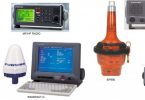Data types
Date and time:
Referenced to UTC with an indication of the source. The source could be the GPS .
Ship’s position:
In latitude and longitude with the datum used. The source could be the GPS .
Speed:
Through water or speed over ground with indication of which it is. The source could be the speed log.
Heading:
As indicated by the ship’s compass. The source could be the gyro compass.
Bridge audio:
As picked up by one or more microphones positioned on the bridge so that conversation at or near the conning stations, radar displays, chart tables, etc., is adequately recorded. As far as practicable, the positioning of microphones should also capture intercom, public address systems and audible alarms on the bridge
VHF communications
Relating to ship operations should be recorded
Radar data:
Electronic signal information from within one of the ship’s radar installations with recording of all the information which was actually being presented on the master display of that radar at the time of recording
If it is impossible to obtain radar data by using a commercially available interface then AIS target data should be recorded as a source of information regarding other ships. If radar data is recorded, AIS information may be recorded additionally as a beneficial secondary source of information on both other and own ship. AIS data is not mandatory, but an option when it is impossible to obtain radar data by means of a commercially available interface.
Additional data:
Items listed by IMO with the requirements set out in resolution A.861(20) should be recorded when the data is available in accordance with the international digital interface standard NMEA0183 using approved sentence formatters. The additional data listed by IMO with the requirements in resolution A.861(20) are:



